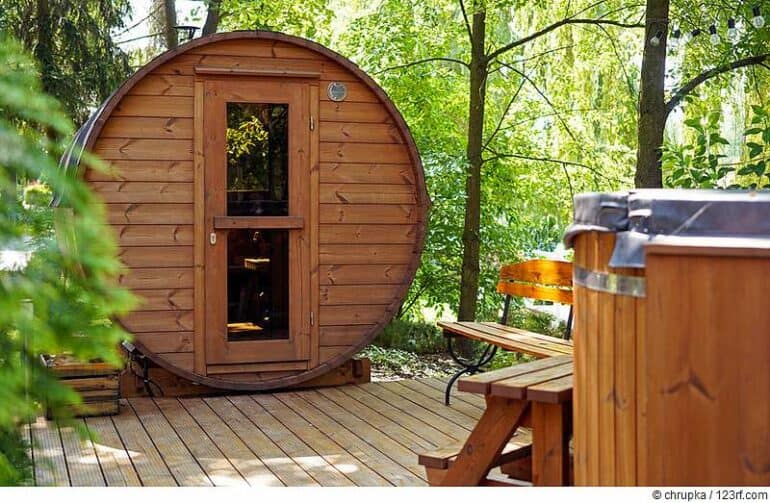Wood preservative varnishes for garden saunas and barrel saunas
The exterior of the sauna should undergo a surface treatment at least once a year to maintain the color tone and appearance, which are affected by sunlight, precipitation and other weather conditions. Wood stains are ideal for exterior painting because they are natural and weather resistant. They also highlight the texture of the wood. Retailers carry a variety of wood stains that can be used to protect all types of wood with ease.
What is the difference between wood stain and linseed oil?
The main component of the glaze is linseed oil, which can be absorbed into the wood. The small, natural pigments bring out the grain of the wood while protecting it from the sun’s ultraviolet rays and moisture. The glaze does not flake or crack. The surface can be painted over without any problems. Depending on the type of wood, the shade you choose can vary greatly. Linseed oil is one of the few oils that hardens in the air. When oiling, the oil penetrates the wood and hardens at that point. In this way, a resistant protective layer is formed.
Why use a glaze and not a varnish?
A glaze is a coating that does not completely cover the surface. Therefore, to protect natural woods from water and dirt, a wood stain is applied. Unlike varnishes or weatherproof paints, wood stains protect and preserve the grain and look of the wood. When wood absorbs moisture, it swells. This natural property of wood is not advantageous for all components. In particular, windows and doors of a garden sauna should be protected from moisture to prevent them from twisting.
Which wood preservatives are suitable?
The wood of an outdoor sauna is subjected to a lot of stress, both from the outside and the inside: Water, cold and UV radiation affect the wood, while from the inside there is extreme heat. Because the interior wood does not suffer any damage, this side is generally left untreated. The high temperatures can release toxic fumes that can harm your health. Therefore, wood preservatives are a no-no in a sauna. The outside, on the other hand, can be protected with a wood stain without any problems. Basically, we distinguish between:
- Wood stains that are breathable, penetrate into the wood and preserve its natural grain.
- Wood paints that cover and leave a superficial layer of color on the wood.
Wood stains are often better in this respect because they do not peel and protect the wood well without closing the pores. Moisture that has penetrated from the inside or outside can easily dry out again in this way. In addition, the coating is usually quite long-lasting. There are translucent glazes that are absolutely colorless, but they also come in all wood tones.
Water-based wood paints, on the other hand, come in every color imaginable and hide the natural color of the wood. If you want a light design for your sauna, this is the right choice. However, the natural drying process can be affected by the large temperature fluctuations between inside and outside and the absorption of water vapor into the wood. This shortens the life of the paint and can lead to moisture damage in the wood under the paint layer.
How do you apply a wood stain?
Wood stains are applied to protect the wood while penetrating deep into the surface. A special glaze brush can be used to apply a wood glaze quickly and precisely. First, lightly dip the glaze brush into the glaze and apply an initial trial coat to a test surface.
Allow the test coat to dry briefly so that the coating can take effect. Continue with even strokes over the rest of the surface. To avoid one-sided fatigue of the affected body parts, apply the sweep from both the arm and wrist. Long and thorough strokes should be used to treat the entire area.
To avoid dripping on the treated surfaces, do not use too much glaze on the brush. Always paint the surfaces with the grain running through. Although the clear wood glaze absorbs quickly and protects the wood from the inside, the corners tend to pick up too much glaze and form dripping spots.
What kind of brush do I use to apply the wood stain?
Brushes come in a variety of shapes and sizes, and how they are used depends on the application. Glaze brushes are available in a variety of thicknesses and sizes. Natural bristles are characterized by the fact that they facilitate the processing of wood glazes and avoid unpleasant streaks and drips. Ring brushes are easily recognized by their round shape.
Due to the possibility of rotation, the ring brush has a relatively large paint storage capacity and provides one of the cleanest painting results of all brushes. Brushes for windows and flat surfaces have a particularly curved shape. These brushes are ideal for working on corners, edges, and other hard-to-reach places. Window and flat surface brushes allow precise painting in difficult and inaccessible places.
Surface brushes and paint rollers are used for larger surfaces. For very large areas with many corners and edges, paint rollers are preferable to area brushes. Paint rollers are the kings of large-area painting.

